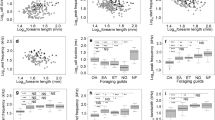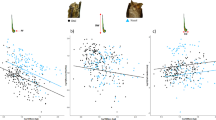Abstract
We investigated intraspecific variation in echolocation calls of the Cape horseshoe bat, Rhinolophus capensis, by comparing echolocation and associated morphological parameters among individuals from three populations of this species. The populations were situated in the center and at the western and eastern limits of the distribution of R. capensis. The latter two populations were situated in ecotones between vegetation biomes. Ecotone populations deviated slightly from the allometric relationship between body size and peak frequency for the genus, and there was no relationship between these variables within R. capensis. Nasal chamber length was the best predictor of peak frequency but not correlated with body size. The evolution of echolocation thus appears to have been uncoupled from body size in R. capensis. Furthermore, females used higher frequencies than males, which imply a potential social role for peak frequency. The differences in peak frequency may have originated from random founder effects and then compounded by genetic drift and/or natural selection. The latter may have acted directly on peak frequency altering skull parameters involved in echolocation independently of body size, resulting in the evolution of local acoustic signatures.




Similar content being viewed by others
References
Anthony EL (1988) Age determination in bats. In: Kunz TH (ed) Ecological and behavioural methods for the study of bats. Smithsonian Institute Press, Washington, DC, pp 47–58
Armstrong KN, Coles RB (2007) Echolocation call frequency differences between geographic isolates of Rhinonicteris aurantia (Chiroptera: Hipposideridae): implications of nasal chamber size. J Mammal 88:94–104
Barclay RMR, Fullard JH, Jacobs DS (1999) Variation in the echolocation calls of the hoary bat (Lasiurus cinereus): influence of body size, habitat structure, and geographic location. Can J Zool 77:530–534
Boughman JW, Wilkinson GS (1998) Greater spear-nosed bats discriminate group mates by vocalizations. Anim Behav 55:1717–1732
Chen S-F, Jones G, Rossiter SJ (2009) Determinants of echolocation call frequency variation in the Formosan lesser horseshoe bat (Rhinolophus monoceros). Proc Biol Sci 276:3901–3909
Cowling RM, Esler KJ, Rundel PW (1999) Namaqualand, South Africa—overview of a unique winter rainfall desert ecosystem. Plant Ecol 142:3–21
Dold T (2003) The rediscovery of Ornithogalum britteniae (Hyacinthaceae) and an amendment to the description. S Afr J Bot 69:500–504
Esser K-H, Schubert J (1998) Vocal dialects in the lesser spear nosed bat, Phyllostomus discolour. Naturwissenschaften 85:347–349
Fenton MB (1985) Communication in the Chiroptera. Indiana University Press, Bloomington
Francis CM, Habersetzer J (1998) Interspecific and intraspecific variation in echolocation call frequency and morphology of horseshoe bats, Rhinolophus and Hipposideros. In: Kunz TH, Racey PA (eds) Bat biology and conservation. Smithsonian Institute Press, Washington, DC, pp 169–179
Gillam EH, McCracken GF (2007) Variability in echolocation of Tadarida brasiliensis: effects of geography and local acoustic environment. Anim Behav 74:277–286
Grilliot ME, Burnett SC, Mendonca MT (2009) Sexual dimorphism in big brown bat (Eptesicus fuscus) ultrasonic vocalizations is context dependent. J Mammal 90:203–209
Guillén A, Juste BJ, Ibáñez C (2000) Variation in the frequency of echolocation calls of Hipposideros ruber in the Gulf of Guinea: an exploration of the adaptive meaning of the constant frequency value in Rhinolophoid CF bats. J Evol Biol 13:70–80
Hartley DJ, Suthers RA (1988) The acoustics of the vocal tract in the horseshoe bat Rhinolophus hildebrandti. J Acoust Soc Am 84:1201–1213
Huffman RF, Henson OW Jr (1993a) Labile cochlear tuning in the mustached bat. I. Concomitant shifts in biosonar emission frequency. J Comp Physiol A 171:725–734
Huffman RF, Henson OW Jr (1993b) Labile cochlear tuning in the mustached bat. I. Concomitant shifts in neural tuning. J Comp Physiol A 171:735–748
Jacobs DS, Barclay RMR, Walker MH (2007) The allometry of echolocation call frequencies of insectivorous bats: why do some species deviate from the pattern? Oecologia 152:583–594
Jones G (1996) Does echolocation constrain the evolution of body size in bats? Symp Zool Soc Lond 69:111–128
Jones G (2008) Sensory ecology: echolocation calls are used for communication. Curr Biol 18(1):R34–R35
Jones G, Barlow KE (2004) Cryptic species of echolocating bats. In: Thomas JA, Moss CF, Vater M (eds) Echolocation in bats and dolphins. The University of Chicago Press, Chicago, pp 345–349
Jones G, Ransome RD (1993) Echolocation calls of bats are influenced by maternal effects and change over a lifetime. Proc Biol Sci 252:125–128
Jones G, Gordon T, Nightingale J (1992) Sex and age differences in the echolocation calls of the lesser horseshoe bat, Rhinolophus hipposideros. Mammalia 56:189–193
Jones G, Sripathi K, Waters DA, Marimuthu G (1994) Individual variation in the echolocation calls of three sympatric Indian hipposiderid bats, and an experimental attempt to jam bat echolocation. Folia Zool 43:347–362
Kark S, Mukerji T, Safriel UN, Noy-Meir I, Nissani R, Darvasi A (2002) Peak morphological diversity in an ecotone unveiled in the chukar partridge by a novel Estimator in a Dependent Sample (EDS). J Anim Ecol 71:1015–1029
Kazial KA, Masters WM (2004) Female big brown bats, Eptesicus fuscus, recognise sex from a caller’s echolocation signals. Anim Behav 67:855–863
Kazial KA, Pacheco S, Zielinski KN (2008) Information content of sonar calls of little brown bats (Myotis lucifugus): potential for communication. J Mammal 89:25–33
Kingston T, Rossiter SJ (2004) Harmonic-hopping in Wallacea’s bats. Nature 429:654–657
Lawrence BD, Simmons JA (1982) Measurements of atmospheric attenuation at ultrasonic frequencies and the significance for echolocation by bats. J Acoust Soc Am 71:585–590
Ma J, Kobayasi K, Zhang S, Metzner W (2006) Vocal communication in adult greater horseshoe bats, Rhinolophus ferrumequinum. J Comp Physiol A 192:535–550
Masters WM, Raver KA, Kazial KA (1995) Sonar signals of the big brown bat, Eptesicus fuscus, contain information about individual identity, age and family affiliation. Anim Behav 50:1243–1260
Matsumura S (1979) Mother-infant communication in the horseshoe bat (Rhinolophus ferrumequinum nippon): development of vocalization. J Mammal 60:76–84
Mucina L, Rutherford MC (2006) The vegetation of South Africa, Lesotho and Swaziland. National Biodiversity Institute, Pretoria
Neuweiler G (1984) Foraging, echolocation and audition in bats. Naturwissenschaften 71:446–455
Neuweiler G, Metzner W, Heilmann U, Rübsamen R, Eckrich M, Costa HH (1987) Foraging behaviour and echolocation in the rufous horseshoe bat (Rhinolophus rouxi) of Sri Lanka. Behav Ecol Sociobiol 20:53–67
Norberg UM, Rayner JMV (1987) Ecological morphology and flight in bats (Mammalia: Chiroptera): wing adaptations, flight performance, foraging strategy and echolocation. Phil Trans R Soc Lond B 316:335–427
Robinson MF (1996) A relationship between echolocation calls and noseleaf widths in bats of the genera Rhinolophus and Hipposideros. J Zool Lond 239:389–393
Russo D, Jones G, Mucedda M (2001) Influence of age, sex and body size on echolocation calls of Mediterranean and Mehely’s horseshoe bats, Rhinolophus euryale and R. mehelyi (Chiroptera: Rhinolophidae). Mammalia 65:429–436
Russo D, Mucedda M, Bello M, Biscardi S, Pidinchedda E, Jones G (2007) Divergent echolocation call frequencies in insular rhinolophids (Chiroptera): a case of character displacement? J Biogeogr 34:2129–2138
Schuchmann M, Siemers BM (2010) Behavioral evidence for community-wide species discrimination from echolocation calls in bats. Am Nat 176:72–82
Schuller G, Pollak G (1979) Disproportionate frequency representation in the inferior colliculus of doppler-compensating greater horseshoe bats: evidence for an acoustic fovea. J Comp Physiol A 132:47–54
Shieh B-S (2004) Song structure and microgeographic variation in a population of the grey-cheeked fulvetta (Alcippe morrisonia) at Shoushan Nature Park, southern Taiwan. Zool Stud 43:132–141
Siemers BM, Beedholm K, Dietz C, Dietz I, Ivanova T (2005) Is species identity, sex, age or individual quality conveyed by echolocation call frequency in European horseshoe bats? Acta Chiropterol 7:259–274
Simmons JA, Stein RA (1980) Acoustic imaging in bat sonar: echolocation signals and the evolution of echolocation. J Comp Physiol A 135:61–84
Stoffberg S (2007) Molecular phylogenetics and the evolution of high frequency echolocation in horseshoe bats (Genus Rhinolophus). Dissertation, University of Cape Town, Cape Town
Stoffberg S, Jacobs DS, Mackie IJ, Matthee CA (2010) Molecular phylogenetics and historical biogeography of Rhinolophus bats. Mol Phylogenet Evol 54:1–9
Stone AW, Weaver AB, West WO (1998) Climate and weather. In: Lubke RA, de Moor I (eds) Field guide to the Eastern and Southern Cape Coasts. University of Cape Town Press, Cape Town, pp 41–49
Suthers RA, Hartley DJ, Wenstrup JJ (1988) The acoustic role of tracheal chambers and nasal cavities in the production of sonar pulses by the horseshoe bat, Rhinolophus hildebrandti. J Acoust Soc Am 162:799–813
Taylor PJ (2000) Bats of Southern Africa. University of Natal Press, Pietermaritzburg
Thabah A, Rossiter SJ, Kingston T, Zhang S, Parsons S, Mya KM, Zubaid A, Jones G (2006) Genetic divergence and echolocation call frequency in cryptic species of Hipposideros larvatus s.l. (Chiroptera: Hipposideridae) from the Indo-Malayan region. Biol J Linn Soc 88:119–130
Vater M, Feng AS, Betz M (1985) An HRP-study of the frequency-place map of the horseshoe bat cochlea: morphological correlates of the sharp tuning to a narrow frequency band. J Comp Physiol A 157:671–686
Wilczynski W, Ryan MJ (1999) Geographic variation in animal communication systems. In: Foster SA, Endler JA (eds) Geographic variation in behaviour: perspectives on evolutionary mechanisms. Oxford University Press, Oxford, pp 234–261
Yoshino H, Armstrong KN, Izawa M, Yokoyama J, Kawata M (2008) Genetic and acoustic population structuring in the Okinawa least horseshoe bat: are intercolony acoustic differences maintained by vertical maternal transmission? Mol Ecol 17:4978–4991
Yovel Y, Melcon ML, Franz MO, Denzinger A, Schnitzler H-U (2009) The voice of bats: how greater mouse-eared bats recognize individuals based on their echolocation calls. PLoS Comput Biol 5:e1000400. doi:10.1371/journal.pcbi.1000400
Zar JH (1999) Biostatistical analysis, 4th edn. Prentice-Hall, New Jersey
Zhuang Q, Müller R (2007) Numerical study of the effect of the noseleaf on biosonar beamforming in a horseshoe bat. Phys Rev E 76:051902. doi:10.1103/PhysRevE.75.051902
Acknowledgments
Thanks to B. D. Kruger, S. Jordaan, A. Thomas, E. Kelly, S. Stoffberg, E. Coeli, C. Hartnick and H. Babiker for assistance in the field. The assistance of Prof. Ric Bernard, Mr. and Mrs. White of Table Farm and Mr. and Mrs. Mostert of Steenkampskraal for access to their respective properties is much appreciated. Thanks also to T. Kearney (Northern Flagship Institute) and D. Hamerton (Iziko Museum) for access to the collections of their respective institutions. Many thanks also to Stephan Steiner and the team of the MRC/UCT Medical Imaging Research Unit, for their assistance with the skull radiographs. Our capture, handling and voucher collection methods were approved by the Science Faculty Animal Ethics Committee (approval number: 2008/V18/LO) of the University of Cape Town. This research was funded by grants to L. J. Odendaal (Prestigious scholarship from the National Research Foundation) and D. S. Jacobs from the South African Research Chair Initiative (funded by the Department of Science and Technology, administered by the National Research Foundation).
Author information
Authors and Affiliations
Corresponding author
Appendix
Appendix
Museum codes for Rhinolophus capensis skulls used in this study:
-
Northern Flagship Institute: TM 27066, TM 29081, TM 29064, TM 29067, TM 29080, TM 29070, TM 29077, TM 29065, TM 29063.
-
Iziko Museum: ZM 14560H, ZM 14559, ZM 14560I, ZM 14561, ZM 35665, ZM 14560E, ZM 14560C, ZM 14560F, ZM 14560B, ZM 14560, ZM 14560G.
Rights and permissions
About this article
Cite this article
Odendaal, L.J., Jacobs, D.S. Morphological correlates of echolocation frequency in the endemic Cape horseshoe bat, Rhinolophus capensis (Chiroptera: Rhinolophidae). J Comp Physiol A 197, 435–446 (2011). https://doi.org/10.1007/s00359-010-0601-x
Received:
Revised:
Accepted:
Published:
Issue Date:
DOI: https://doi.org/10.1007/s00359-010-0601-x




